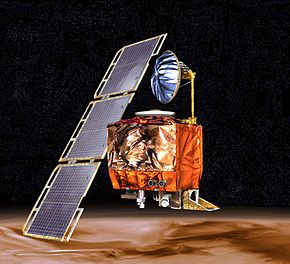1. SI Units
The ability to use units correctly is essential for scientists and engineers. Mistakes can be expensive:
|
Quiz 1: What caused NASA's Mars Climate Orbiter probe to crash?
(a)It was hit by a meteoriteIncorrect - please try again!
(b)AliensIncorrect - please try again!
(c)A mix-up over unitsCorrect - well done!
(d)Metal fatigue in a boosterIncorrect - please try again!
|

|
Explanation: The Mars Climate Orbiter was launched by NASA in 1998 and crashed into the planet Mars in 1999. An investigation concluded that a mix-up about the units of the force of correction thrusters was responsible for the spacecraft hitting the Martian atmosphere at the incorrect angle and breaking up.
NASA uses SI units but the Lockheed Corporation which made the thrusters used English units. The conversion factor was forgotten and so the `correction' rocket firings caused the expensive probe to be destroyed.
Moral: You should always state the units that you are using!
Scientists and engineers use SI (Systéme International) units. Some of the basic units, which we will use in this module, are:
| Quantity | Unit | Symbol |
|---|---|---|
| Length | Metre | m |
| Time | Second | s |
| Mass | Kilogram | kg |
Note that the kilogram (rather than the gram) is the SI unit of mass.
Many other units are derived from these base units. For example, the unit of area is square metres, metres times metres, which we write as m2. Similarly, the unit of volume is cubic metres, metres times metres times metres, written as m3. (This follows the rules discussed in the module on Powers.)
Example 1: What are the SI units of speed? Speed is the distance travelled per unit of time:
Thus, units of speed = m s-1. This is read as metres per second.
Quiz 2: What are the SI units for the density (mass per unit volume) of any substance ?
Note that the only situation where you do not need to give units is for dimensionless ratios, e.g. the ratio of two distances or the ratio of two masses. These are independent of the units used, as the following example illustrates.
Example 2: A motoring atlas gives the distance from Plymouth to Lands End as 143km or 89miles. The distance from Plymouth to John O'Groats is stated to be 1271km or 790miles. The ratio of the two distances is:
| Plymouth to John O'Groats Plymouth to Lands End | = | 1271km 143km | = | 8.9 |
| or | = | 790miles 89miles | = | 8.9 |
It is nearly 9 times as far to John O'Groats as it is to Lands End, no matter whether you use kilometres or miles to measure distances. In other words, the ratio does not depend upon the units used.
Exercise 1: Calculate the following in SI units:
Solution: The area of a square is the length of its side squared:
| Area | = | 1m × 1m |
| = | 1m2 |
The area is therefore 1 square metre (or 1 metre squared).
Solution: The volume of a cube is given by the cube of the length of its side:
| Volume | = | 0.5m × 0.5m × 0.5m |
| = | 0.53m3 | |
| = | 0.125m3 |
The volume is therefore 0.125 cubic metres (or 0.125 metres cubed).
Solution: Speed is given by distance over time. So:
| Speed | = | 10m2s |
| = | 5m s-1 |
The average speed of the dog was therefore 5 metres per second.
Solution: Since the density is the mass per unit volume we have:
| Density | = | 0.8kg 0.2m3 |
| = | 4kg m-3 |
The density is therefore 4 kilograms per metre cubed (or 4 kilograms per cubic metre).
Click on questions to reveal solutions
Quiz 3: The frequency of a wave is defined as the number of cycles (or oscillations) per unit time. What are the SI units of frequency?
Explanation: Frequency is the number of oscillations per second. The number of oscillations is just a number and does not depend on any choice of units. The units of time are seconds:
| Units of frequency | = | 1 Units of time |
| = | 1 s | |
| = | s-1 |
The SI unit of frequency is cycles per second. This unit is also called a Hertz (Hz).
Quiz 4: Acceleration is defined as the rate of change of speed with time. What are the SI units of acceleration?
Explanation: Acceleration is the rate of change of speed with time. The units of speed arem s-1 and the units of time ares. So:
| Units of acceleration | = | Units of speed Units of time |
| = | m s-1 s | |
| = | m s-2 |
The SI unit of acceleration is metres per second per second. This can also be said as metres per second squared.
A constant acceleration of 10m s-2 means that the speed of the object increases by 10m s-1 every second.
2. Derived Units
Some physical quantities are so widely used that their units have special names. They are called derived units because they are defined in terms of the base SI units.
Example 3: The SI unit of force is the Newton (N). Let us see how it is constructed in terms of base units:
Force is defined by:
One Newton is short for one kilogram metre per second squared, i.e., it is the force needed to accelerate one kilogram by one metre per second squared.
Quiz 5: The SI unit of energy is the Joule (J). From the expression for kinetic energy E = ½mv2, where m is the mass and v is the speed of the object, express the Joule in terms of the base SI units:
Explanation: From the equation for kinetic energy, E = ½ m v2, we see that its units must be:
The unit of speed is m s-1, so:
| Units of energy | = | kg × (m s-1)2 |
| = | kg m2 s-2 |
One Joule is therefore one kilogram metre squared per second squared.
Exercise 2: Express the following in terms of base SI units:
Solution: Pressure is force per unit area. So:
The SI units of force are kg m s-2 and the units of area are m2, so we obtain:
| Units of pressure | = | kg m s-2 m2 |
| = | kg m-1 s-2 |
One Pascal is thus one kilogram per metre per second squared.
Solution: Power is the rate of use of energy. So:
The SI units of energy are kg m2 s-2 and the units of time are s, so we obtain:
| Units of power | = | kg m2 s-2 s |
| = | kg m2 s-3 |
One Watt is thus one kilogram, metre squared per second cubed. It is much easier to understand what this unit means if we recall that the derived unit of energy is the Joule. We thus simply say that a power of one Watt is one Joule per second. This shows the usefulness of derived units.
Click on questions to reveal solutions
Exercise 3: Calculate the following in SI units:
Solution: If a wave oscillates 100 times in 2 seconds, the frequency is given by:
| Oscillations per second | = | 100 2s | = | 50s-1 |
| or | = | 50Hz |
Solution: The ball moves through 6m in 2s. But to calculate its kinetic energy, let us first express its mass of 200g in SI units, This is 200 ⁄ 1000 = 0.2kg. The average speed is:
| Speed | = | Distance Time | ||
| v | = | 6 2 | = | 3m s-1 |
We now substitute this into the formula for kinetic energy E = 1 / 2 m v2:
- where we recall that the Joule is the SI unit of energy.
Solution: Pressure is force over area. So if we apply 60N to 3m2, we obtain:
| Pressure | = | 60N 3m2 |
| = | 20Pa |
- where we recall that a Pascal is a Newton per metre squared.
Solution: If the device uses 100Joules in one tenth of a second then its power is:
| Power | = | 100Joules 0.1s |
| = | 1000W |
- where we recall that a Watt is a Joule per second. (Note that Joules is usually abbreviated as J).
Click on questions to reveal solutions
3. Scientific Notation
We encounter many large and small numbers in science. Scientic notation (also called standard form) makes manipulating them easier, where the number is written as one (non-zero) digit followed by the decimal places, all multiplied by the appropriate power of ten.
Example 4: Express the astronomical unit (AU), the mean distance from the Earth to the Sun, in scientic notation.
Since 1AU = 15,000,000,000,000m, it may be written as:
Example 5: A great advantage of scientic notation is that it is easy to multiply and divide numbers written in this way. For example, if a = 3 × 106 and b = 2 × 108, then from the module on Powers, we have:
4. Prefixes
No single unit of length will be appropriate for describing, say, the distances between positions on a silicon chip and the separations of the planets in the solar system. To be able to do this we use prefixes (as in the familiar 1000m = 1km, where `k', which is short for kilo, means one thousand). Here are some of the more widespread prefixes:
| Prefix | Factor | Symbol |
|---|---|---|
| giga | 1,000,000,000 = 109 | G |
| mega | 1,000,000 = 106 | M |
| kilo | 1,000 = 103 | k |
| mil | 0.001 = 10-3 | m |
| micro | 0.000001 = 10-6 | μ |
| nano | 0.000000001 = 10-9 | n |
So there are one thousand grams in a kilogram and one thousandth of a second is a millisecond.
Example 6: A surveyor measures the distance by road from Plymouth to Lands End to be 143,000m. What is this in kilometres?
Since 1km = 1,000m, we have:
Exercise 5: Express the following with the requested prefix:
Solution: To express 12.7nm in metres, we first need to recall that 1nm = 1 × 10-9m. Therefore:
| 12.7nm | = | 12.7 × 1 × 10-9m |
| = | 1.27 × 10-8m |
Solution: Air pressure at sea level is roughly 101kPa. Since 1kPa = 100Pa:
| 101kPa | = | 101 × 1,000Pa |
| = | 101,000Pa |
Solution: The thrust of Smart 1's ion drive is 0.07N. Since one milli-Newton is 1/1000th of a Newton, one Newton is 1,000mN:
This can be compared with the liftoff thrust of the Ariane V rocket, which is 15,360kN. However, the ion drive is designed to run for a much longer time than the Ariane launch.
Solution: If the power of each of the ten turbines is 400kW, the total power is 4,000kW. To express this in mega-Watts, recall that 1kW = 103W and MW = 106W.
Therefore:
| 1kW | = | 103106 |
| = | 10-3MW |
From this we have:
| 4,000kW | = | 4,000 × 10-3MW |
| = | 4MW |
So the total power of this, the UK's first commercial wind farm, is 4MW.
5. Quiz on Units
Choose the solutions from the options given
